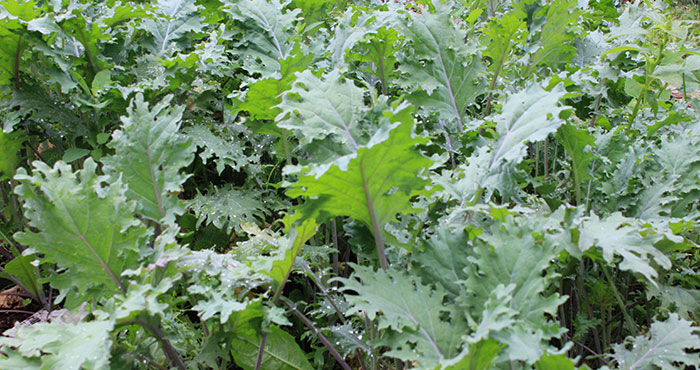5 Vegetables You Can Harvest All Winter Long

Have you noticed that hint of an autumn chill in the air? The days are getting shorter, but the vegetable planting season isn’t over yet! If you’ve been limiting your vegetable garden to one growing season, it might be time to try something new.
These five vegetables still have time to reach a harvestable size before they go dormant. As the days become shorter throughout October and November, they’ll slow down and then stop growing. But they won’t die back.
With proper care, these hardy vegetables will stay alive all winter long, and you can harvest them at your leisure. Basically, you’ll be using your garden beds or containers as a living, outdoor refrigerator.
Ready for fresh winter veggies? Start with these tried-and-true favorites.
Radishes
Veritable sprinters of the vegetable world, radishes can go from seed to your salad bowl in less than a month. We don’t even carry starts for them here at Sky because they’d be practically ready to harvest before they left our shelves!
We recommend sowing a succession of radish plantings every two weeks from early spring through fall for a continuous harvest of these crisp garden treats. If you want a steady harvest all winter, plant a few extra rows in late August and early September.
While hot weather can make radishes too spicy for some people’s tastes, winter-harvested radishes are mild and crisp. Fresh radishes can be a reminder of spring on even the gloomiest winter days.
In the fall, mulch your radishes with leaves or straw to protect them from any sudden changes in temperature. For extra protection, you can throw floating row cover over the bed, or put together a simple cloche. Whenever you want a few radishes to garnish a soup or add zing to a winter-time spring roll (why not?), just pull the mulch aside and harvest what you need.
Carrots
For full-sized winter carrots, it’s best to plant before the end of July. However, there’s nothing wrong with sowing a little later and harvesting tender baby carrots as-needed through the winter months. Smaller plants are more cold-tolerant than larger ones, and quick-maturing carrot varieties still have time to put on at least a little girth. Baby carrots are wonderful in all kinds of winter dishes, and even those tender carrot greens can be put to good use.
If you’ve ever sown carrot seeds, you know that they are super tiny. It’s almost impossible to keep them evenly spaced, and most gardeners end up with a dense thicket of carrot seedlings that can crowd each other out. If you plant now, you can harvest and thin at the same time, whenever you feel like it, all winter long. By spring, your remaining seedlings will have much more room to grow.
As with radishes, a fluffy layer of mulch should be plenty to protect your overwintering carrots, but a cloche or floating row cover can’t hurt.
Beets
Overwintered beets are the candy of the vegetable garden (except they’re way better for your health). Summer and fall beets are deliciously sweet in their own rights, but they just can’t compete with their post-frost counterparts. Cold-hardy plants use sugar as natural anti-freeze, and beets are masters of this trick.
Treat your overwintering beets just like you would carrots. Plant a little more densely than the seed packet or plant tag recommends, protect them with mulch, harvest small beets and beet greens all winter, and then watch the remaining plants take off in the spring.
Mixed Baby Greens
Now is the perfect time to plant greens for fresh, fancy salads all winter long. Mixed greens make an especially great choice for winter container gardens, since their shallow roots don't need much room.
You can buy salad green mixes as either seeds or starts, make your own mix by combining your favorite leafy green varieties, or plant separate rows of each variety and mix them post-harvest. Try mixing any combination of arugula, mustard greens, spinach, leaf lettuces, kale, and Swiss chard.
Direct sowing is the easiest way to plant overwintering baby greens. Just use your fingers to create shallow furrows or rough up a patch of soil, sprinkle the seeds about a a half-inch apart, cover with a thin layer of soil, and water.
When your greens are about 3-6 inches tall, they’re ready to harvest. Use scissors to snip the plants about halfway down. Harvest as much as you need, and leave the rest for the next harvest. The cut plants will re-grow for a second harvest once the light returns in the spring.
Make sure to protect your salad mix from the cold with floating row cover or a cloche. If your mix includes lettuce, a sturdy cloche, cold-frame, or greenhouse may be necessary to prevent it from freezing.
Kale
Last but not least, this classic winter vegetable is a true champion. With proper care, this super-hardy leafy green can thrive without protection all winter long, even in regions much colder than ours.
Like other overwintering vegetables, kale gets much sweeter in the winter. If you plant starts now, they’ll have time to reach a respectable size before they stop growing for the season. If you start from seeds, you might want to consider them part of your baby greens mix.
Once your plants are established, harvest individual leaves as needed throughout the winter and early spring. When the weather begins to warm up, mature kale plants will burst into bright yellow blooms. The leaves can become bitter and tough at this point, but not to worry! You can eat the flowering stems and buds just like broccoli raab, and use the edible flowers as garnish for spring salads.
